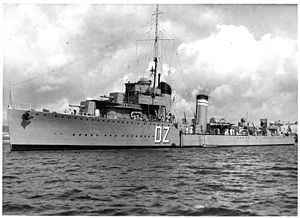
Back Třída Churruca Czech Clase Churruca Spanish ناوشکن کلاس چروکا Persian Churruca-luokka Finnish Classe Churruca Italian チュルカ級駆逐艦 Japanese Эскадренные миноносцы типа «Чуррука» Russian
 Destroyer José Luis Diez
| |
| Class overview | |
|---|---|
| Name | Churruca class |
| Builders | SECN, Naval Dockyard, Cartagena. |
| Operators | |
| Preceded by | |
| Succeeded by | |
| Subclasses |
|
| Built | 1923–1951 |
| In commission | 1927–1982 |
| Completed | 18 |
| Lost | 2 |
| Retired | 16 |
| General characteristics | |
| Type | Destroyer |
| Displacement |
|
| Length | 101.50 m (333 ft 0 in) oa |
| Beam | 9.68 m (31 ft 9 in) |
| Draught | 3.20 m (10 ft 6 in) |
| Installed power |
|
| Propulsion | 2 Parsons turbines |
| Speed | 36 knots (67 km/h) |
| Range | 4,500 nmi (8,300 km) at 14 knots (26 km/h) |
| Complement | 175 |
| Armament |
|
The Churruca class was a Spanish destroyer class built for the Spanish Navy based on a British design. Eighteen ships were built, with two being sold to Argentina and commonly referred to as the Cervantes class. The last two members of the class are sometimes referred to as a separate class, the Alava class.
The ships were authorized on 17 February 1915 by Navy Minister Augusto Miranda y Godoy. The program planned for four light cruisers, six destroyers, 28 submarines, three gunboats, and 18 coast guard vessels; of these, five light cruisers, three Alsedo and fourteen Churruca-class destroyers, 16 submarines, and the three gunboats were actually completed. The class was built in three groups, with the first group beginning construction in 1923 and the final group's construction delayed by the Spanish Civil War and World War II which led to their completion only in 1957. Some of the later ships of the class were completed without the central gun due to an arms embargo during the Spanish Civil War.
The Churruca class took part in the Spanish Civil War as part of the Spanish Republican Navy, with one being lost in battle. Following the end of the civil war, the destroyers were integrated into the navy of Francoist Spain. They continued in service until the 1950s–1960s when they were discarded. The two completed after World War II remained in service until the early 1980s.